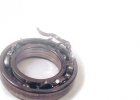Bearing damages: typical causes and suggested remedies
| PROBLEM / DAMAGE | CAUSE | REMEDY | |
|---|---|---|---|
| Noise | High pitched metallic noise | Poor lubrication | Improve lubrication |
| Clearance too small | Correct clearance | ||
| Poor fitting | Investigate mounting method and seating | ||
| Excessive load | Examine shaft and housing tolerances for closing effect | ||
| Low pitched metallic noise | Brinelled raceway surface | Avoid shock loads | |
| Regular noise | Rust and damage | Check and replace seals and relubricate | |
| Flaking of raceway surface | Improve lubrication and check fitting, clearance and fixing method. | ||
| Irregular noise | Ingress of foreign matter | Check and replace seals and relubricate | |
| Excessive clearance | Correct clearance | ||
| Damage and flaking of rolling element | Reduce load and/or clearance | ||
| Variable noise | Variable clearance due to temperature changes | Check fits taking housing material and temperature into consideration | |
| Damage to raceways | Improve lubrication and check fitting, clearance and fitting method | ||
| Heavy vibration | Flaking of raceway and rolling element | Improve lubrication and check fitting, clearance and fitting method | |
| Ingress of foreign matter |
Check and replace seals and relubricate |
||
| Excessive load | Correct clearance | ||
| Poor location | Ensure abutment face and fitting diameter are perpendicular | ||
| Excessive heat generation | Clearance too small | Correct clearance | |
| Poor location | Ensure abutment face and fitting diameter are perpendicular | ||
| Excessive load | Examine shaft and housing tolerances for closing effect | ||
| Poor lubrication | Improve lubrication | ||
| Creep | Maintain recommended shaft and housing fits | ||
| Lubrication failure | Too much grease | Use correct lubricant quantity | |
| Ingress of foreign matter | Check and replace seals and relubricate | ||
| Flaking | Flaking on one side of entire raceway | Excessive axial load by poor fitting or linear expansion | Use clearance fit on non-rotating bearing outer ring |
| Flaking at rolling element pitch on raceways | Raceways brinelled during fitting | Careful fitting | |
| Corrosion during down time | Apply corrosion protective | ||
| Premature flaking of raceway and rolling element surfaces | Excessive load |
Check fitting Correct clearance Use correct lubricant quantity |
|
|
Clearance too small |
|||
| Poor lubrication | |||
| Poor fitting | |||
| Corrosion | |||
| Flaking across the raceway | Poor fitting and eccentricity | Fitting and centering with care | |
| Shaft deflection | Use bearing with larger internal clearance | ||
| Geometric inaccuracy of shaft and housing | Shaft and abutments to be square | ||
| Flaking around raceway | Poor housing accuracy | Check geometric accuracy of housing bore | |
| Indentations | Indentations on raceway at rolling element pitch | Shock loads during fitting or poor handling | Handling with care |
| Excessive static load | Check static load | ||
| Overrolling | Ingress of foreign matter | Ensure cleanliness of components and integrity of seals | |
| Pick-up |
Discolouration of raceway and rolling element surface Softening of surface |
Excessive load |
Check fitting |
|
Clearance too small |
Correct clearance |
||
| Poor lubrication |
Use correct lubricant quantity |
||
| Poor fitting | Check fitting method | ||
| Electrical erosion | Raceway eroded at regular intervals | Arcing due to the bearing conducting electricity | Ground the bearing, insulate the bearing |
| Fracture | Raceway surface fracture | Excessive shock loads | Correct loading |
| High interference fit | Proper fitting | ||
| Increase of flaking and softening; welding of inner ring to shaft | Ensure correct geometry of shaft and housing | ||
| Corner fillet radii | Correct fillet radii | ||
| Rolling element fracture | Excessive shock loads | Correct loading | |
| Excessive internal clearance | Check fitting and clearance | ||
| Cage fracture | Tilting moments | Fit with care | |
| High speed impulse and high acceleration | Ensure uniform rotation | ||
| Incorrect lubrication | Check lubricant and lubrication method | ||
| Ingress of foreign matter in bearing | Improve sealing | ||
| Skidding | Scoring of raceway and rolling element surfaces | Hard grease | Use soft grease |
| High start-up acceleration | Control acceleration | ||
| Abrasion | Extreme abrasion of raceway, rolling element and cage | Ingress of foreign matter |
Improve sealing Improve lubrication |
| Corrosion | |||
| Poor lubrication | |||
| Creep | Loose fit | Correct tolerances and fitting | |
| Incorrectly fixed | Correct fixing | ||
| False brinelling | Vibration in non-rotating bearing |
Insulate bearing from vibration Use oil as lubricant Apply preload |
|
| Small oscillations in application | |||
| Corrosion | Rust inside bearing | Poor storage | Careful storage and handling |
| Condensation | |||
| Rust on fitting surface | Fretting | Increase interference fit | |
| Fluctuating load | Use oil as lubricant | ||
| Corrosion | Ingress of acid, alkali or gas | Check sealing | |
| Chemical reaction with lubricant | Use correct lubricant | ||

